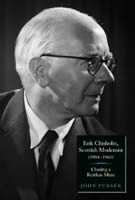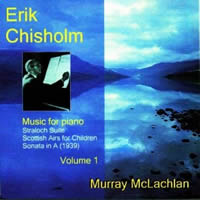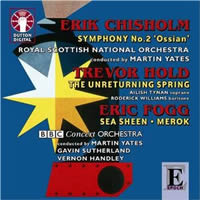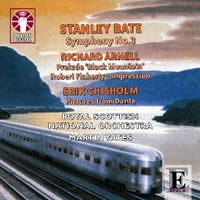Awrite, Erik Chisholm!
|
[December 2010.]
John PURSER: Erik Chisholm, Scottish Modernist 1904-1965: Chasing a Restless Muse (2009). Boydell & Brewer (http://www.boydellandbrewer.com/) ISBN 978-1-84383-460-1. “Music for Piano, Volume 1.” Erik CHISHOLM: Straloch Suite (1933); Scottish Airs for Children (ca. 1940-49); Sonata in A, “An Riobain Dearg” (1939; rev. McLachlan, 2004). Murray McLachlan (pno). Divine Art ddv24131 (http://www.divine-art.com/). Erik CHISHOLM: Symphony No. 2, “Ossian” (1939)1. Trevor HOLD: The Unreturning Spring, Op. 3 (1961-63)2. Eric FOGG: Sea-Sheen: an idyll, Op. 17 (1920)3; Merok (1929)4. Royal Scottish National Orchestra1, Martin Yates1 (cond.); Ailish Tynan2 (sop), Roderick Williams2 (bar), BBC Concert Orchestra2, 3, 4, Martin Yates2, Gavin Sutherland3, Vernon Handley4 (conds.). Dutton Epoch CDLX 7196 (http://www.duttonvocalion.co.uk/). Distributed in the US by Harmonia Mundi (http://www.harmoniamundi.com/). Erik CHISHOLM: Pictures from Dante (after Doré) (1948). Stanley BATE: Symphony No. 3 (1940). Richard ARNELL: Prelude “Black Mountain,” Op. 46 (1946); Robert Flaherty – Impression, Op. 87 (1958). Royal Scottish National Orchestra, Martin Yates (cond.). Dutton Epoch CDLX 7239 (http://www.duttonvocalion.co.uk/). Distributed in the US by Harmonia Mundi (http://www.harmoniamundi.com/). Erik Chisholm (1904-1965) is the most interesting 20th-century Scots musician you’ve never heard of. You could call him MacBartók for his blending of folk material with avant-garde styles. Actually, it may be better to compare him to László Lajtha — like Chisholm an unfamiliar name outside his own country, a hard-working composer, performer, educator and all-around music promoter who found inspiration among his country’s folk-music yet could be greatly influenced by other sources. Deeper than an overview and broader than a monograph, Purser interleaves biography and analysis with commentary that brings Chisholm’s labors into focus. Appendices list works, recordings and other examples of the musician’s endeavors. Building a concert series in Glasgow, Chisholm imported Hindemith, Sorabji, Medtner, Casella, Bartók and Busch. Sorabji’s December 1, 1930 appearance was the only time the composer / pianist played Opus Clavicembalisticum in public. Chisholm turned pages for Bartók, played piano four-hands with Casella, and performed Szymanowski’s music with the composer in attendance. He arranged Alkan’s Symphony from the Op. 39 Études for string orchestra, and gave the Scottish premieres of many operas, including Les Troyens and Idomeneo. Chisholm conducted and performed in Nova Scotia, Italy and India, established Singapore’s first symphony orchestra (1946), and spent his last 19 years in South Africa running the College of Music. He was among the first to write about Janáček. Mackerras contributed the Foreword to Purser’s biography which recounts their meeting in Cape Town and discussing the Czech composer’s operas. Chisholm was a guest of the USSR in July and August 1957. Traveling through Helsinki, he discovered Sibelius in the phone book. Chisholm’s wife had to discourage him from ringing up the great Finn at 2:15 in the morning. In the Soviet Union, he met Kabalevsky, Bulganin and Khrushchev, and sat on a competition jury with Shostakovich (Purser’s biography includes a photo of the two together). Chisholm’s visit was met with enthusiasm: The state offered to publish his Celtic Song Book. He purchased over 70 LPs on this trip. Chisholm sought literary topics for his operas, including Dark Sonnet (1952), based on O’Neill, several settings of Chaucer’s Tales (1961, 1962), The Importance of Being Ernest (1963) after Wilde, and The Caucasian Chalk Circle (1963) after Brecht. He found relationships between Celtic and Indian music: the Piano Concerto No. 2, “The Hindustani” (1948-49), the Violin Concerto (1951), and the concerto for orchestra, Van Riebeeck Concerto (1950-51). He used chromatic ragas which eventually led him to embrace dissonance and dodecaphony, e.g., the opera Simoon (1953). Judging purely on reputation and description, Chisholm’s music promises to entertain. Two orchestral recordings don’t appear to represent Chisholm’s most innovative or modern aspirations. The operas and vocal works are unavailable. However, Murray McLachlan has recorded several discs of Chisholm’s piano music which now appear under the Divine Arts umbrella on the Dunelm Records Diversions series. Considering McLachlan’s first release, Chisholm comes into focus as a gifted composer for the piano. These works predate much of his travels and are steeped in his homeland’s melodies. Except for the Scottish tunes, the three-part Straloch Suite with its first movement fugato could be Busoni. The prevalence of diatonic motifs combined with the second movement’s rhythmic patterns suggest that Nyman may have inspected Chisholm or explored some of the same sources when working on The Piano. Scottish Airs for Children easily earns Chisholm the MacBartók moniker. Drawing upon airs from a 1784 publication by Patrick MacDonald, Chisholm may have intended to construct a graded anthology for his three daughters. There are 22 airs in the collection. The Sonata in A, “An Riobain Dearg,” is a barnstormer. Chisholm taps into a Highland theme and variations format, the piobaireachd, generally associated with bagpipes. But there are no wheezy drones in these four movements. He employs virtuosic decoration, willfully abandoning harmony to explore embellished melodies. Sorabji and Bartók are clear influences, the latter in a driven 3+3+2 scherzo. The moody slow movement mourns the loss of the submarine HMS Thetis, which sank killing 99 during its first trials on June 1, 1939. The somber finale is demanding and acrobatic. On the basis of this release alone Chisholm warrants serious examination, and McLachlan would be his greatest advocate. (Purser wrote the notes.) I am well outside Dutton Epoch’s target audience; their roster is generally unfamiliar, but I admire their industry. Two Dutton releases (2007 and 2009) offer some of what must be Chisholm’s less adventurous orchestral music. The discs’ filler made little impression. Chisholm was a keen recycler of his own music. Completed in 1939, parts of the Second Symphony were reused for a ballet, The Earth-Shapers (1941). The 1948 Pictures from Dante (after Doré) borrows from an earlier comic ballet, Piobaireachd. This Second is possible only because of reconstructive sleuthing. Its three movements contain six distinctive parts, presumably depictions or illustrations of the life and deeds of the Celtic hero Ossian. The noble sweep suggests Sibelius. The notes observe how contemporaries were busy contemplating The Great War, with Chisholm perhaps seeking influences elsewhere. Skillfully orchestrated, the dynamic Dante (dedicated to pal Sorabji) stands apart from discmate Arnell’s thin items and Bate’s Third with its puzzling Shostakovich-like anticipations. Dramatically, even harmonically, it doesn’t stray far from Liszt, but there’s a touch of the exotic and a clear comfort with polytonality. Chisholm handles Doré’s images operatically. More time is spent ringing in Paradisio’s chorales than Inferno’s brimstone (12:42 against 9:11). As with the Second, the debt to Sibelius is clear. It would seem that the Dante Pictures have been performed only three times: in Vienna (1952), South Africa (1960) and Scotland (2008). Of the Ossian’s companions, Hold’s The Unreturning Spring sets texts by James Farrar, killed in action in 1944. Seven poems alternate between soprano and baritone, and a tiny interlude requires winds to improvise with birdcalls. The five-minute Sea-Sheen was written by a 17-year-old Fogg. Merok offers variations on a Norwegian folk song.
[More Books, Grant Chu Covell]
[Previous Article:
Diabelli Days]
[Next Article:
Threes and Sevens]
|



